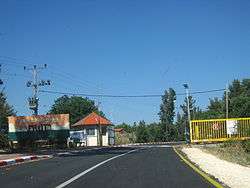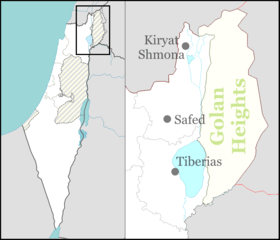Keshet, Golan Heights
Keshet (Hebrew: קֶשֶׁת) is an Israeli settlement and moshav shitufi in the Golan Heights. It was established in 1974 after the Yom Kippur War by Hapoel HaMizrachi near the Syrian city of Quneitra, which had been abandoned and subsequently razed to the ground in the Six-Day War.[2] Its name is a translation of the name Quneitra ("arch"). In 2019 it had a population of 799.[1]
Keshet קֶשֶׁת | |
|---|---|
 | |
 Keshet | |
| Coordinates: 32°58′49″N 35°48′30″E | |
| Country | Israel |
| District | Northern |
| Council | Golan |
| Region | Golan Heights |
| Affiliation | Hapoel HaMizrachi |
| Founded | 1974 |
| Population (2019)[1] | 799 |
The international community considers Israeli settlements in the Golan Heights illegal under international law, but the Israeli government disputes this.[3]
History
Keshet was established in the period between the cease-fire and armistice agreement following the Yom Kippur War by national-religious demonstrators who opposed an Israeli withdrawal to the pre-war line. They initially settled in a bunker in the fringes of Quneitra, but were forced to relocate to an abandoned Syrian farm when Quneitra was returned to Syria as part of the armistice agreement. Four months later, the Israeli government agreed to establish the settlement, and the settlers moved to another temporary location in an abandoned Syrian military camp further west. The settlement at its present location was established in 1978.
Geography
Keshet is situated near the volcanic cone of Mount Peres at 710 meters (2,330 ft) above sea level. It is located just south of Highway 87 between the Keshet Junction and the Bashan Junction.
Economy
The community's economy is based on agriculture and tourism, and it has a field school and a religious mechina (military preparatory institution).
See also
References
- "Population in the Localities 2019" (XLS). Israel Central Bureau of Statistics. Retrieved 16 August 2020.
- Andrew Beattie, Timothy Pepper, The Rough Guide to Syria 2nd edition, p. 146. Rough Guides, 2001. ISBN 1-85828-718-9
- "The Geneva Convention". BBC. 10 December 2009.
External links
- About Keshet (in Hebrew)